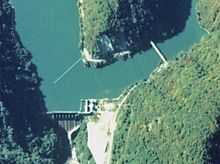Tsubawara Dam
From Wikipedia, the free encyclopedia
| Tsubawara Dam | |
|---|---|
 Overview of the dam in 1977 | |
 | |
| Country | Japan |
| Location | Shirakawa, Gifu Prefecture |
| Coordinates | 36°18′45″N 136°53′51″E / 36.31250°N 136.89750°ECoordinates: 36°18′45″N 136°53′51″E / 36.31250°N 136.89750°E |
| Purpose | Power |
| Status | Operational |
| Construction began | 1952 |
| Opening date | 1953 |
| Dam and spillways | |
| Type of dam | Gravity |
| Impounds | Shō River |
| Length | 201.7 m (662 ft) |
| Height | 68.2 m (224 ft) |
| Dam volume | 163,000 m3 (213,000 cu yd) |
| Spillway type | Crest overflow, 7 tainter gates |
| Reservoir | |
| Total capacity | 22,274,000 m3 (18,058 acre·ft) |
| Active capacity | 5,788,000 m3 (4,692 acre·ft) |
| Catchment area | 665.7 km2 (257.0 sq mi) |
| Surface area | 1.16 km2 (0.45 sq mi) |
| Normal elevation | 460.5 m (1,511 ft) |
| Power station | |
| Commission date |
Original: 8 January 1954 New: 27 March 1975 |
| Turbines |
Original: 1 x 42 MW Francis-type New: 1 x 65 MW Francis-type |
| Installed capacity | 107 MW |
The Tsubawara Dam, also known as the Tsubakihara Dam, is a gravity dam on the Shō River about 5 km (3.1 mi) north of Shirakawa in Gifu Prefecture, Japan. It was constructed between 1952 and 1953. The dam has an associated 107 MW hydroelectric power station which was built in two parts. The first part of the power station (42 MW) was commissioned in 1954 and the second part of the power station (65 MW) was commissioned in 1975. Of the nine dams on the Shō River it is the seventh furthest downstream.[1][2]
See also
- Narude Dam – downstream
- Hatogaya Dam – upstream
References
- ↑ "Kansai Electric Power Tsubawara power plant" (in Japanese). Suiryoku. Retrieved 28 July 2013.
- ↑ "Kansai Electric Power new Tsubawara power plant" (in Japanese). Suiryoku. Retrieved 28 July 2013.
| Wikimedia Commons has media related to Tsubakihara Dam. |
This article is issued from Wikipedia. The text is available under the Creative Commons Attribution/Share Alike; additional terms may apply for the media files.